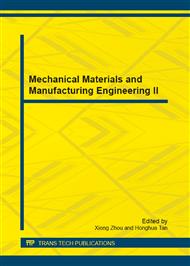p.387
p.391
p.395
p.402
p.408
p.413
p.422
p.426
p.433
Cutting Parameters Optimization of Thin-Walled Workpiece Based on PSO and FEM
Abstract:
An approach to optimize the cutting parameters based on Particle Swarm Algorithm(PSO) and Finite Element Method(FEA) was proposed. A cutting parameters optimization model was established whose design variables are the cutting parameters and objective function is to minimize the maximum deformation. PSO was used to optimize the cutting parameters and FEA was utilized to predict the machining deformation of the thin-walled workpiece. Finally, the entire technique was demonstrated in a case study. The simulation and experimental results show that the approach can be further employed into the practical machining situation.
Info:
Periodical:
Pages:
408-412
Citation:
Online since:
December 2012
Authors:
Price:
Сopyright:
© 2013 Trans Tech Publications Ltd. All Rights Reserved
Share:
Citation:


